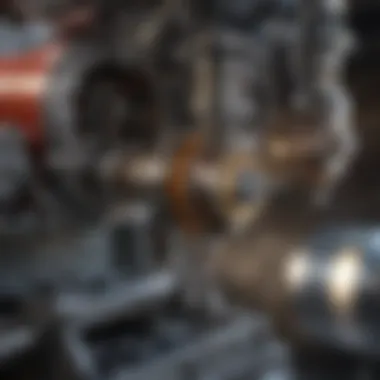Understanding Globe Mixer Parts: A Comprehensive Guide


Intro
Globe mixers are essential in agricultural processes, playing a critical role in blending various materials to ensure uniformity and quality. Understanding the intricate parts of these mixers is vital for both operators and maintenance personnel. Each component contributes significantly to the overall effectiveness of the mixer and, therefore, the success of agricultural practices on farms.
A globe mixer consists of several essential parts, each serving a distinct function. Knowledge of these components empowers users to operate and maintain the equipment effectively, leading to better performance and increased efficiency. As we explore the various elements, we will highlight their relevance in the context of agricultural mixing applications.
Key Concepts and Terminology
Definition of Terms
In grasping the mechanics behind globe mixers, it is important to define some key terms:
- A mixing chamber: This is the main compartment where the ingredients are combined. Its design influences the mixing process.
- Agitation system: This includes the blades or paddles, which facilitate the movement of materials within the chamber.
- Feed system: The method by which raw ingredients are loaded into the mixer, often involving hoppers or conveyors.
- Discharge system: This refers to the mechanism that allows processed material to exit the mixing chamber, usually through valves or openings.
Importance in Agriculture
Globe mixers significantly improve operational efficiency in agriculture by ensuring a consistent mixture of nutrients, seeds, or feed. This uniformity is essential for promoting healthy crop growth and livestock feed nutrition. Operating a globe mixer properly maximizes performance and minimizes waste. Understanding these components leads to informed decisions on maintenance and usage, ultimately enhancing productivity.
Current Trends and Innovations
Technological Advancements
Recent years have seen enhancements in globe mixer designs. Modern mixers incorporate automated controls for precise ingredient measurement, reducing human error. This technology ensures that the mixing process is optimized for efficiency.
Sustainable Practices
Sustainability has become a priority in agricultural equipment design. Many new models prioritize energy efficiency and reduced carbon footprints. These advancements not only benefit the environment but also reduce operating costs for farmers.
Best Practices and Techniques
Step-by-Step Guides
To enhance the longevity and efficiency of globe mixers, following best practices is crucial:
- Regular Cleaning: Keep the mixing chamber and utensils clean to avoid contamination.
- Routine Inspections: Check components for wear and tear, including blades and seals.
- Calibration: Regularly adjust settings for accurate measurements and blending.
Tools and Resources
Utilizing the right tools enhances mixing efficiency. Consider using:
- Cleaning brushes designed for mixers.
- Digital scales for precise ingredient measurements.
- Maintenance guides to track servicing schedules.
"Understanding the components of globe mixers is vital for enhancing operational efficiency."
Prologue to Globe Mixers
In agricultural operations, globe mixers play a pivotal role in the mixing of various materials. Understanding the components and functionality of these mixers is crucial for improving productivity. This section lays the groundwork for what globe mixers are, their function, and historical context.
Definition and Functionality
A globe mixer is a type of equipment used to blend ingredients efficiently and uniformly. Its primary function is to facilitate the mixing of solids, liquids, or semi-solids in an agricultural setting. These mixers are designed with a variety of key components that work together to ensure thorough mixing.
The mixing chamber is a central feature. It allows materials to move freely while getting combined. The shape of the chamber plays a role in how effectively materials blend. The impeller, another vital part, creates motion in the chamber, ensuring even distribution of materials. Thus, the functionality of globe mixers significantly enhances the quality of the end product and reduces the time needed for mixing tasks.


Historical Development
The development of globe mixers is an interesting journey that reflects advancements in agricultural technology. Early mixing devices were simple and often required manual labor. Over time, as agriculture grew more mechanized, the need for efficient mixing solutions became apparent.
The first significant innovations in mixer technology occurred in the mid-20th century. Engineers began designing mixers that utilized powerful motors, improving mixing speed and efficiency. The globe mixer gained popularity due to its effectiveness in various agricultural applications, from feed mixing to soil blending. As agricultural practices evolved, so did the design and functionality of mixers. Today, these machines incorporate advanced technology to enhance performance, such as automated controls and variable speed drives.
Understanding the historical context of globe mixers helps in appreciating their importance in modern agriculture. It reveals how these machines have evolved to meet the ever-changing demands of the industry.
Overview of Globe Mixer Design
Understanding the design of globe mixers is essential for anyone using this equipment in agricultural contexts. The overall structure of the mixer influences its mixing performance, operational efficiency, and longevity. In this section, we will examine the architectural aspects of globe mixers, including their structural components and material choices. These factors are critical in determining how well the mixer functions and how it integrates into agricultural workflows.
Structural Components
The structural components of a globe mixer play a vital role in its performance. Each part contributes to the operation, influencing the quality of the mixing process. The primary structural components typically include the mixing chamber, impeller, and drive assembly.
- Mixing Chamber: This is the core of the mixer where materials come together. Its design can influence mixing efficiency significantly. For example, a well-designed chamber promotes flow patterns that enable thorough mixing.
- Impeller: Often the most critical component, the impeller design affects how materials are mixed. Different types of impellers are used for specific tasks. Choosing the right impeller for the intended purpose can lead to more favorable mixing outcomes.
- Drive Mechanism: The mechanism that powers the mixer needs to be robust and reliable. This component ensures that the impeller operates at the necessary speed to achieve the desired mixing results.
Each of these structural components must be well-engineered to work together effectively. Failure in any part can affect overall performance.
Material Considerations
The materials used in the construction of globe mixers also bear great importance. They influence the mixer’s performance, durability, and maintenance needs. Various materials come into play, including metals, plastics, and composite materials. Choosing the right material is essential for several reasons.
- Durability: Mixers are often subjected to harsh conditions. Using high-quality materials can reduce wear and tear.
- Corrosion Resistance: Some agricultural materials can be corrosive. Components made of resistant materials will last longer.
- Weight: The material choice can significantly influence the overall weight of the mixer, affecting mobility and placement.
In agricultural applications, a mixer must not only perform well but also withstand the demands of the work environment. Careful selection of both structure and materials contributes to improved performance and a longer lifespan of the equipment.
Key Components of Globe Mixers
The key components of globe mixers play a central role in determining their efficiency and effectiveness in various agricultural applications. Understanding these parts allows users to make informed decisions, not only when it comes to repairs and maintenance but also regarding their selection for specific mixing tasks. Each part has distinct functions that contribute to the overall performance of the mixer. By examining these components, users can appreciate their importance in the process of achieving optimal mixing outcomes.
Mixing Chamber
The mixing chamber is a critical element of a globe mixer. It is the space where the actual blending of materials occurs. The design of this chamber significantly impacts how well materials mix together. A well-designed mixing chamber promotes a uniform distribution of ingredients, which is essential for consistency in the final product. The shape and size of the chamber can vary based on the specific application. Factors like the type of materials being mixed and the desired end result must be considered when choosing a mixer with the right mixing chamber.
- A larger mixing chamber may accommodate greater volumes, but this can sometimes lead to inefficient mixing if not properly utilized.
- Conversely, a smaller chamber can provide more intense mixing but may require more frequent emptying and refilling for larger tasks.
The material used in constructing the mixing chamber also matters, as it can influence the durability and longevity of the mixer. Common materials include stainless steel and high-grade plastic, which resist corrosion and wear.
Impeller Types
Impellers are essential for creating the motion needed to thoroughly mix the contents in the mixing chamber. There are several types of impellers, each designed for different types of mixing tasks. Understanding these types is crucial for selecting the right mixer for specific agricultural needs.
Common impeller types include:
- Radial Impellers: These types push the mixture outward from the center. They are often used when rapid mixing is required, thanks to the strong centrifugal force they generate.
- Axial Impellers: These pull materials from the top down, promoting a more vertical flow pattern. They are beneficial for ensuring that lighter materials are evenly integrated with denser substances.
- Diagonal Impellers: These offer a compromise between radial and axial flow, enabling versatility in handling various material types.
Choosing the right impeller type can vastly improve the efficiency of the mixing process, thus affecting the quality of the final product.
Drive Mechanism
The drive mechanism is what powers the mixer and determines its operational capability. Different types of drive mechanisms affect the speed and efficiency of mixing. The choice of a drive system can have significant implications for the mixing process and should align with the specific requirements of the materials being combined.


Common options include:
- Electric Drives: These are widely used due to their efficiency and ease of use. Electric drives offer precise speed control, which can be critical for achieving optimal mixing results.
- Hydraulic Drives: While less common, they can be more powerful and are used in situations requiring heavy lifting or mixing large volumes.
- Pneumatic Drives: These utilize air pressure and are suitable for lighter mixer designs often found in smaller agricultural setups.
Understanding the advantages and disadvantages of each drive mechanism is essential for anyone looking to invest in a globe mixer. It ensures that the selected equipment meets the necessary performance requirements while optimizing mixing processes.
Understanding the Mixing Process
The mixing process is critical in agriculture, particularly when using globe mixers. This process involves blending various materials to achieve a uniform consistency, which is essential for effective implementation in different applications, including feed production and soil amendment. Understanding how this process functions can tremendously impact the quality of the final product and enhance productivity.
Mechanics of Mixing
The mechanics of mixing revolve around the interaction between different materials in the mixing chamber. As the globe mixer operates, the materials are subjected to forces that promote blending. These forces include shear, turbulence, and diffusion. Each plays a unique role in ensuring that all components are uniformly distributed throughout the mixture.
The mixer uses an impeller designed to create turbulence, which helps lift and toss ingredients within the chamber. Depending on the type of impeller used, the mixing action can vary, altering the time it takes to achieve a homogeneous blend. Understanding these mechanics allows users to optimize mixing times and adjust parameters to meet specific material requirements.
Factors such as material viscosity and particle size influence how effectively mixing occurs. Greater viscosity may require longer mixing times or more powerful machinery. An optimal mix is not just about achieving a homogenous blend but also preventing over-mixing that can lead to ingredient damage.
Factors Influencing Mixing Efficiency
Several factors influence the efficiency of the mixing process in globe mixers.
- Material Properties: Different materials behave differently. For example, powders can clump together, while liquids can segregate based on viscosity. Understanding the physical characteristics of materials helps in creating the right mixing strategy.
- Mixer Design: The design of the globe mixer, specifically the type and shape of the impeller, affects how well materials are mixed. A well-designed mixer will enhance mixing efficiency by promoting even distribution of materials during operation.
- Operating Conditions: The speed at which the mixer operates also plays a key role. Higher speeds create more turbulence, which can enhance mixing but may also lead to over-mixing.
- Batch Size: The size of the batch being mixed can affect the distribution of materials. Small batches may not mix as thoroughly as larger ones, therefore impacting overall quality.
Understanding these factors not only aids in achieving optimal mixing conditions but also enhances the overall effectiveness of the globe mixer in agricultural applications. Ensuring that operators are aware of these nuances can lead to better resource management and improved product outcomes.
Importance of Maintenance and Care
Maintaining globe mixers is crucial for optimal performance and longevity. Proper care ensures that the equipment operates efficiently and minimizes the risk of breakdowns. Regular maintenance can save costs associated with repairs and replacements, making it an essential practice for agricultural professionals.
A well-maintained mixer enhances productivity. When mixers operate at their peak performance, they can handle higher volumes and achieve consistent mixing quality. This issue is especially relevant in agricultural applications where precision in mixing can impact the quality of feed and other agricultural products. Without proper care, mixers may face inefficiencies that can lead to inconsistent products.
Moreover, adhering to a maintenance schedule can extend the life of the globe mixer. Just like any machinery, neglecting regular maintenance can lead to wear and tear, which ultimately results in costly downtime. Careful attention to maintenance can improve safety as well. Failing components can pose risks during operation, making regular checks a safety priority.
Routine Maintenance Practices
Routine maintenance practices for globe mixers are straightforward but require discipline. Key practices include:
- Inspection: Regularly inspect the mixing chamber, impellers, and drive mechanisms for signs of wear.
- Cleaning: Ensure that the mixer is clean after each use to prevent build-up of materials.
- Lubrication: Apply lubricant to bearings and moving parts according to the manufacturer’s specifications.
- Calibration: Periodically calibrate the instruments to maintain accuracy in measurements.
- Tightening: Check and tighten all bolts and screws to ensure structural integrity.
Incorporating these practices into a maintenance routine helps track the mixer’s condition and performance over time.
Troubleshooting Common Issues
Despite regular maintenance, issues may still arise with globe mixers. Being able to recognize and troubleshoot common problems can minimize downtime. Some typical issues include:
- Inconsistent Mixing: This may result from improper calibration of the impeller speed or a malfunctioning motor.
- Excessive Noise: Unusual noises often indicate friction between moving parts or loose components.
- Wear on Impellers: Over time, impellers can become worn and require replacement to maintain efficiency.
- Electrical Failures: Check fuses and wiring if the mixer fails to start or operate correctly.
For each issue, the first step is to diagnose the root cause. This might involve consulting the technical manual or seeking advice from experienced users. Addressing problems swiftly can restore function and minimize disruptions to agricultural operations.
Best Practices for Selecting Globe Mixers
Choosing the right globe mixer is critical for enhancing productivity and efficiency in agricultural operations. A proper selection can lead to improved mixing outcomes, ensuring a consistent and homogeneous product. This section aims to provide insights into best practices when selecting globe mixers. It will detail specific factors, benefits, and considerations to help the reader make informed decisions.


Criteria for Selection
When selecting a globe mixer, multiple criteria come into play. These factors directly impact the mixer’s performance and suitability for specific tasks.
- Capacity: Determine the mixing capacity required for your operations. Consider both the volume and the ingredients being processed to ensure the mixer can handle the workload efficiently.
- Mixing Speed: Different glob mixers have varying mixing speeds. Higher speeds might be beneficial for certain applications, whereas others may require a slower, more thorough mixing process. Choose according to the material’s nature.
- Durability and Build Quality: Assess the construction materials. Stainless steel is typically preferable due to its resistance to corrosion and ease of cleaning. A sturdy design can prolong the mixer’s lifespan.
- Ease of Maintenance: Select a mixer that offers easy access to components for cleaning and repairs. This impacts both the downtime during maintenance and the efficiency of routine cleaning tasks.
- Energy Efficiency: Opt for models designed with energy-efficient motors. These mixers may initially cost more, but they offer savings in operational costs over time.
- Versatility: Consider whether the mixer can handle multiple tasks or types of materials. A versatile option can cater to evolving needs, thus justifying your investment.
When the criteria align with your specific needs, you can increase productivity without compromising quality.
Comparative Analysis of Brands
The market offers various globe mixer brands, each with unique attributes. Understanding these brands can assist in selecting the most suitable option for agricultural applications.
- Hobart: Known for their robust build and versatile performance, Hobart mixers come with different attachments and capacities for tailored mixing solutions. Their reputation for endurance is notable.
- Berkel: Berkel provides compact mixers that excel in smaller operations, where space is limited. Their design emphasizes user-friendliness and precise control over mixing processes.
- Vita-Mix: Renowned for its high-speed blending capabilities, Vita-Mix is particularly effective for fluid or semi-solid materials. Their equipment caters well to diverse agricultural needs.
- Braman: Braman focuses on eco-friendly designs. Their mixers often incorporate energy-efficient technology, appealing to those looking to reduce operational costs while minimizing environmental impact.
Evaluating these brands requires looking against the established criteria. Each choice can lead to different operational outcomes, thus emphasizing the need for careful consideration.
"Selecting a globe mixer involves more than just price. Understanding the specific needs of your operation is crucial to make the right choice."
Ending
The conclusion of this article offers a chance to reflect on the intricate world of globe mixers and their essential components. Recognizing the importance of each part gives a deeper understanding of how they contribute to mixing efficiency in agricultural practices. With this knowledge, farmers and enthusiasts can make informed decisions regarding the selection and maintenance of these vital devices.
Summary of Insights
In the previous sections, we have dissected several aspects of globe mixers, focusing on their design, key components, mixing processes, and the importance of routine maintenance. Each part, from the mixing chamber to the drive mechanism, plays a significant role in determining the mixer’s efficiency and effectiveness. Understanding these elements allows users to optimize their usage and prolong the lifespan of their equipment. Here are some insights to take away:
- Importance of Design: The structural design greatly influences mixing performance. A well-thought-out mixing chamber encourages efficient material distribution.
- Component Interrelation: Each component interacts with others, impacting overall functionality. For example, the type of impeller can affect how well ingredients are combined.
- Maintenance is Key: Regular maintenance prevents issues and extends the operational life of globe mixers. Troubleshooting common problems helps keep equipment running smoothly.
These insights underscore the multifaceted nature of globe mixers, showcasing their role in efficient agricultural practices.
Future Perspectives in Mixer Technology
As we look ahead, several trends appear to reshape the landscape of mixing technology in agriculture. Innovations focusing on sustainability and efficiency are paving the way for new developments.
- Smart Technologies: The integration of IoT (Internet of Things) in agricultural machinery is on the rise. Smart globe mixers can provide real-time data about performance, enhancing user understanding and control.
- Sustainable Practices: The push for more environmentally friendly practices means manufacturers may focus on eco-friendly materials and energy-efficient operations. This can lead to advancements in mixer designs, aiming for lower emissions and better resource usage.
- Automation and Robotics: As technology advances, automation may become more prevalent in agriculture. Automated globe mixers can reduce labor costs and increase precision in mixing processes.
Appendix: Additional Resources
The appendix section serves as a vital resource providing supplementary information relevant to the comprehensive guide on globe mixer parts. This is particularly important as it supports the main content, offering further insights and tools for both novice and experienced users in agricultural contexts. By having access to additional materials, farmers and enthusiasts can deepen their understanding and efficiently address their unique mixing needs.
Including this appendix encourages readers to expand their knowledge beyond the core topics covered in the article. It comprises valuable references that enhance comprehension and execution of maintenance and usage tasks. The benefits of this section are manifold, as it highlights critical learning opportunities and practical guides that solidify the reader’s foundational learning.
Moreover, this appendix acknowledges that learning is an ongoing process. New materials, methods, and technologies emerge regularly. Readers that wish to stay informed about the latest advancements in mixer technology can leverage the resources provided here to stay updated. This helps in making informed decisions regarding equipment selection and upkeep.
Further Reading Materials
Further reading materials are instrumental for those who wish to delve deeper into the subject of globe mixers. Various resources can include:
- Academic journals focusing on agricultural technology.
- Books that explore the mechanics behind various mixing processes.
- Online articles and blogs written by industry experts that share insights.
These materials add dimension to the primary narrative presented in the article. Therein, readers can uncover additional nuances and real-world applications of globe mixers.
Technical Manuals and Guidelines
Technical manuals and guidelines are essential documents for operators of globe mixers. They provide detailed instructions and specifications for optimal equipment use. These manuals often cover:
- Proper operation protocols to ensure safety and effectiveness.
- Maintenance schedules that help in prolonging the lifespan of the mixer.
- Troubleshooting guidelines to address common operational issues.
Having these resources accessible is crucial for preventing minor issues from escalating. Technical guidelines also help in aligning operational practices with manufacturer recommendations, thus ensuring peak performance.
Readers are encouraged to refer to industry-reputable sources for acquiring relevant technical manuals. Websites like Wikipedia, Britannica, Reddit, and Facebook can provide leads to helpful materials.



